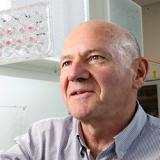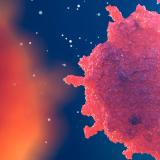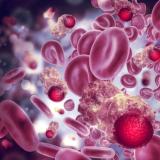One in eight Australian women will be diagnosed with breast cancer in their lifetime and seven women die from the disease each day in Australia1
For more than 30 years Professor Wayne Tilley has been on the trail of one of Australia’s biggest killers—breast cancer. Understanding how sex hormones interact has been key to unlocking a clever strategy to switch off ‘bad’ genes in breast cancer.
Professor Tilley and the team at the University of Adelaide set up Australia’s leading research centre dedicated to breast and prostate cancer research. About 75 per cent of breast cancers and almost 100 per cent of prostate cancers are driven by their respective hormone receptors—estrogen and androgen.
‘What you find with these sex hormones is that after they bind to their receptor in a tumour cell, the hormone receptor sits on specific sites in DNA to turn on ‘bad’ genes involved in the growth, survival and spread of the cancer,’ Professor Wayne Tilley explained.
‘We’ve known for many years that along with estrogen receptors there are progesterone receptors in breast tumours. The presence of progesterone receptors is used to predict the response to treatments that target the estrogen receptor pathway.
'What we have discovered recently is that when progesterone receptors are activated they bind to the estrogen receptor to either push or pull it to different sites on the DNA—essentially reprogramming it to stimulate a ‘good’ gene pathway to perform normal cell functions and inhibit tumour growth.'
For over 70 years traditional therapies to combat estrogen-positive breast cancers have used more and more sophisticated methods of blocking the estrogen receptor pathway. Side effects from blocking this pathway, especially using drugs that prevent the production of estrogen, include joint pain, loss of libido, impairment of cognitive function, and early menopause.
This research funded by NHMRC has focussed on understanding how to best exploit the reprogramming of the estrogen receptor by using natural progesterone. Additionally, androgen receptors—also found in the majority of breast cancer cells—can be exploited.
For women who don’t have the progesterone receptors (about 22 per cent), or are postmenopausal and do not have sufficient progesterone of their own, androgen receptors—activated by androgens—compete with estrogen receptors rather than reprogramming them to inhibit tumour growth.
'So now we can offer options—we can activate the progesterone receptor to reprogram the estrogen receptor or we can activate the androgen receptor to directly block the activity of the estrogen receptor. This gives us two new weapons in the armoury to control the growth of estrogen-dependent breast cancer', Professor Tilley explained.
‘Patients will still have the current standard of care—estrogen receptor pathway blockers—but we are looking at whether combining these drugs will improve the outcome.
‘The other great benefit of progesterone and androgen therapies, especially the latter, is they can improve quality of life by reducing the often debilitating side effects from estrogen receptor blocking treatments.’
Professor Tilley and the team have also developed a new model for testing breast cancer tumours called patient derived explants. This involves growing small fragments of a tumour on a gelatin sponge in a special culture dish. This is done within one hour after a tumour has been removed from a patient. This means the team is able to assess the likelihood of a tumour responding to a wide range of treatments.
‘We are increasingly using models like this that are as close as we can get to doing an experiment in humans to ensure we can take forward the best leads and facilitate better outcomes for patients. This is helping us fast-track our research,’ Professor Tilley said.
‘We are also pretty excited that progesterone may be used in conjunction with standard of care quite quickly—two to three years—because being a drug already in use with good safety data, it doesn’t have to go through all the regulatory hurdles.2’
This NHMRC Project Grant was fundamental in understanding how this reprogramming works, particularly in the breast. This type of grant helps to create new knowledge by funding the best investigator-initiated research in any area relevant to human health.
‘Core funding from NHMRC is critical but to maximise the value of the funding we don’t work in a vacuum, we work with some of the best people in the world,’ Professor Tilley said.
‘We have extremely good national and international collaborative alliances to ensure we are using the latest and the best methods and models. We interface with cancer survivors and contemporary clinical trialists to ensure that our research is focussed on the most important clinical questions and can be rapidly translated into the clinic.’
Leveraging off the NHMRC grant, Professor Tilley in collaboration with colleagues at the University of Adelaide, Monash University, the Garvan Institute for Medical Research and Cambridge University (UK) has just received a linkage grant from the National Breast Cancer Foundation and the Movember Foundation in Australia.
‘This new grant looks at whether we can translate what we’ve learnt in estrogen-sensitive breast cancer into treatment-resistant disease states and whether a similar reprogramming strategy can be used for the androgen receptor in prostate cancer.’
1Cancer Australia, Breast Cancer Statistics; https://breast-cancer.canceraustralia.gov.au/statistics, accessed 17 October 2017
2Note: Many contraceptives and certain forms of Hormone Replacement Therapies (HRT) contain derivatives or synthetic forms of progesterone that seem to act differently. These are not the natural progesterone drugs that are being tested.



